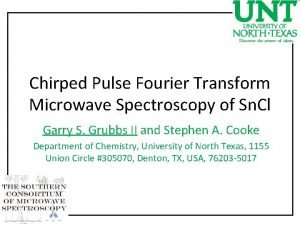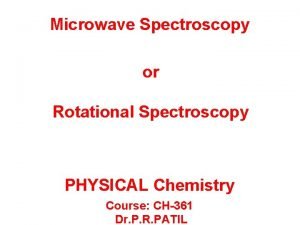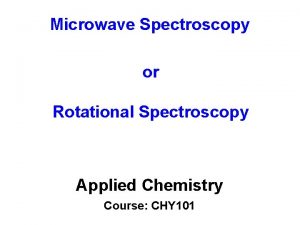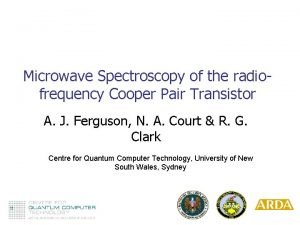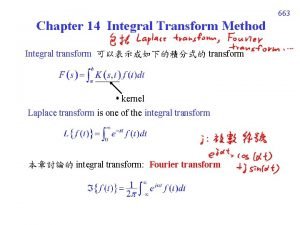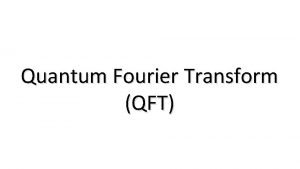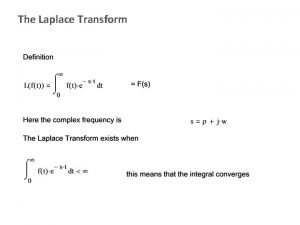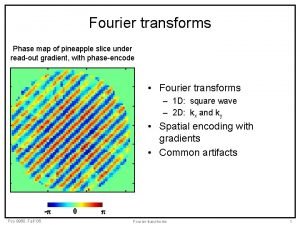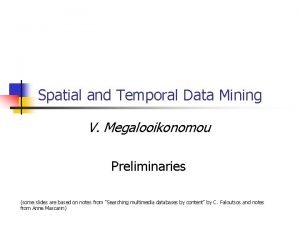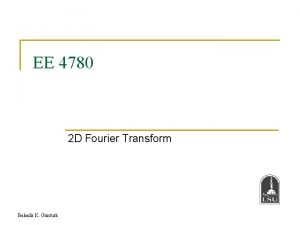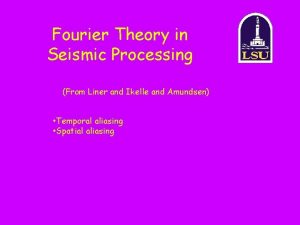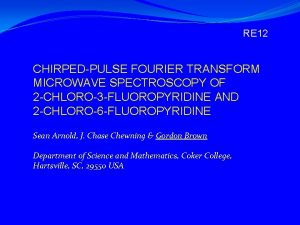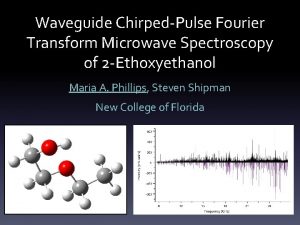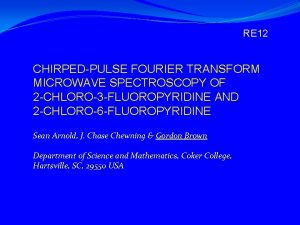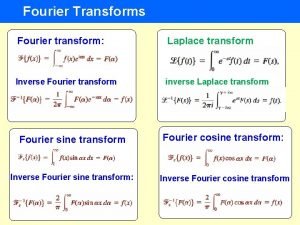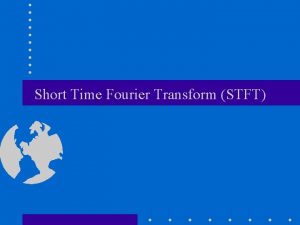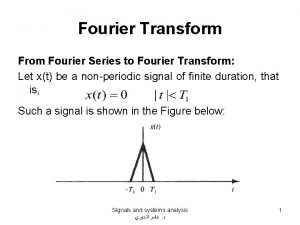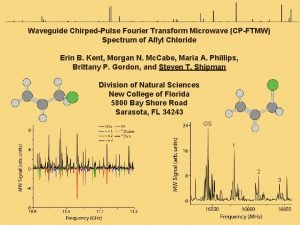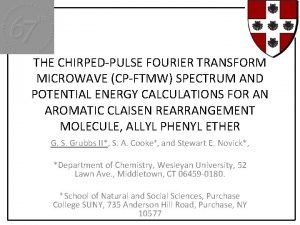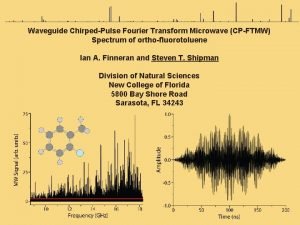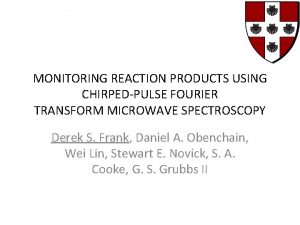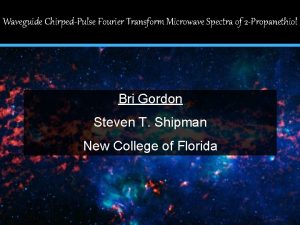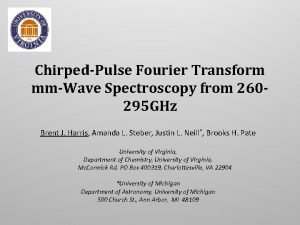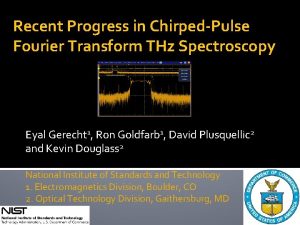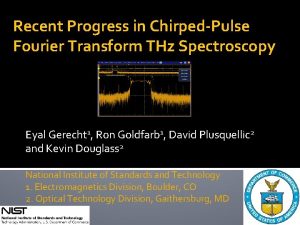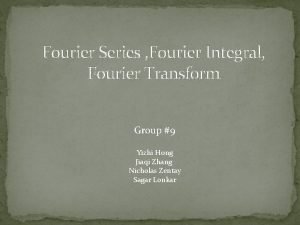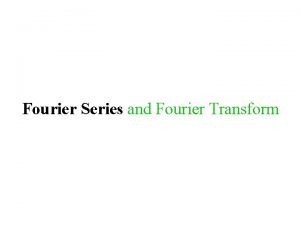TwoDimensional ChirpedPulse Fourier Transform Microwave Spectroscopy Modeling Coherence


















- Slides: 18

Two-Dimensional Chirped-Pulse Fourier Transform Microwave Spectroscopy: Modeling Coherence Transfer David Wilcox Purdue University Department of Chemistry 560 Oval Dr. West Lafayette, IN 47907 -2084 65 th Ohio State University International Symposium on Molecular Spectroscopy 6/22/2010

Motivation • 2 D CP-FTMW spectroscopy surpasses several limitations of previous waveguide methods: • Pulse shaping • Sequence mode • Increased bandwidth of detection • Differences in the methods: • Phase-cycling • Aliasing with multiple coherences • Selection rules for dipole-forbidden coherences • Vogelsanger and Bauder used the density matrix formalism to explain three-level systems. • The goal of this work is to extend the formalism of the three-level system to an N-level system. B. Vogelsanger and A. Bauder, J. Chem. Phys. 92, 4101 (1990) OSU Molecular Symposium 6/22/2010

Modeling Coherence Transfer with the Liouville-von Neumann Equation: Evolution of the Density Matrix = Time independent rigid rotor Hamiltonian = Transition dipole vector (dipole moment) = Electric field, treated classically and sinusoidally Off-diagonal Matrix Elements OSU Molecular Symposium 6/22/2010

The Hamiltonian Matrix: 4 Level System Purely Progressive (Ladder Configuration) Purely Regressive (W Type) OSU Molecular Symposium 6/22/2010

The Density Matrix: The Progressive 4 Level System First Term: Energy level populations Populations over quantum and statistical mechanical probabilities along the diagonal. OSU Molecular Symposium 6/22/2010

The Density Matrix: The Progressive 4 Level System Second Term: Dipole allowed single quantum coherences d c b a Single coherent superposition of selection rule allowed energy levels. The coherence oscillates at the characteristic resonant frequency of the transition. OSU Molecular Symposium 6/22/2010

The Density Matrix: The Progressive 4 Level System Third Term: Double quantum coherences described by the density matrix Set to zero d c b a Multiple photons access dipole-forbidden transitions. This study determined that 3 rd and higher order coherences are not detectable, and thus the approximate phenomenological density matrix selection rule states: OSU Molecular Symposium 6/22/2010

The Density Matrix: The Regressive 4 Level System Set to zero d c b Similar development of the density matrix for a regressively connected energy level scheme. Dipole forbidden quantum beats oscillate with a difference of adjacent transitions sharing a common energy level. This restriction yields the approximate density matrix selection rule: a OSU Molecular Symposium 6/22/2010

Modeling Coherence Transfer • After the Hamiltonian and density matrix are defined, the rotating wave approximation is made and the solutions to the Liouville-von Neumann equation are solved numerically. • The four general periods of a two-pulse 2 D experiment are preparation (A), t 1 evolution (B), mixing (C), and t 2 detection (D). The state of the system at the end of each period serves as initial conditions for the subsequent period. B t 1 evolution C mixing probe pump A preparation D t 2 detection OSU Molecular Symposium 6/22/2010

Demonstrating the Validity with a 3 Level System: Trifluoropropyne Autocorrelation Pulse Sequence Sampling at the Nyquist rate requires too many data points to practically record. Intentional under-sampling at 1 ns step size gives 500 MHz of bandwidth in t 1 detection, so shifts in transition frequencies are observed. Transition Frequency → Observed Frequency 3 ΔJ = 2← 2 1: 11511 MHz → 488 MHz ΔJ = 3← 3 2: 17267 MHz → 267 MHz Energy Level Scheme t 1 (Scan) probe 1 Autocorrelation Pulse Sequence pump 2 OSU Molecular Symposium 6/22/2010

TFP Autocorrelation 1 D Spectrum: Identifying Peak Types 3 C A 488 MHz A 2 C B C 267 MHz C C C 1 Energy Level Scheme A: Direct coherence information (267 & 488 MHz) B: Double quantum coherence (Quantum mixing) C: Classical mixing off of carrier frequency *Intensities derived from Boltzmann probabilities at thermal equilibrium OSU Molecular Symposium 6/22/2010

Regressive 4 Level System: 1 -Chloro-1 Fluoroethylene Autocorrelation Experiment Transition Frequency → Observed Frequency ΔF = 0. 5← 0. 5 1. 5: 14120 MHz → 120 MHz ΔF = 2. 5← 2. 5 1. 5: 14128 MHz → 128 MHz F=1. 5 F=2. 5 F=0. 5 111 ΔF = 1. 5← 1. 5: 14138 MHz → 138 MHz Energy Level Scheme 000 t 1 (Scan) probe F=1. 5 pump Autocorrelation Pulse Sequence OSU Molecular Symposium 6/22/2010

Raw 1 D Slice of CFE: Enhancement of Spectral Features 138 128 F=2. 5 120 F=1. 5 CFE Energy Level Scheme Comparison of 2 D plot vs. 1 D slice of the same plot. Small spectral features are accentuated and much more spectral detail is seen in the 1 D slice which is lost in larger plot. OSU Molecular Symposium 6/22/2010

Additional Spectral Features of 1 D Slice: A Closer Look A C 138 128 B 120 CFE energy level scheme of the 111 -000 transition, ΔF = 2. 5← 1. 5 A: Fundamental (Coherence) B: Quantum mixing (Beats) C: Classical mixing (Harmonics) OSU Molecular Symposium 6/22/2010

Closer-er View of the Coherence Peaks Coherences from adjacent regressive transitions are present in 1 D slice. 128 120 138 F=1. 5 F=2. 5 138 128 F=0. 5 120 F=1. 5 OSU Molecular Symposium 6/22/2010

1 D Slices of CFE Hyperfine Transitions ΔF= 0. 5← 1. 5 138 120 MHz: ΔF= 0. 5← 1. 5 Parent 120 128 128 MHz: ΔF= 2. 5← 1. 5 Coherence * 120 138 ΔF= 1. 5← 1. 5 138 MHz: ΔF= 1. 5← 1. 5 Weak *Classical Mixing 128 138 120 MHz: ΔF= 0. 5← 1. 5 Weak 128 120 * 120 128 MHz: ΔF= 2. 5← 1. 5 Coherence 138 MHz: ΔF= 1. 5← 1. 5 Parent OSU Molecular Symposium 6/22/2010

Conclusion and Future Direction • Three-level system of Vogelsanger and Bauder has been extended to describe peaks in 1 D slices of higher order systems accessible with CP-FTMW spectroscopy. • Phenomenological density matrix selection rules are needed to account for quantum mixing peaks. • Formalism used to implement quantum computing logic gates using broadband rotational spectroscopy. • Defer further applications to Kelly Hotopp’s talk, TC 12. OSU Molecular Symposium 6/22/2010

Acknowledgments Funding: Dian Research Group: Purdue University Kelly Hotopp Amanda Shirar Brian Dian Camille and Henry Dreyfus Foundation OSU Molecular Symposium 6/22/2010
 Chirped pulse fourier transform microwave spectroscopy
Chirped pulse fourier transform microwave spectroscopy Rotational spectroscopy notes
Rotational spectroscopy notes Rotational spectroscopy
Rotational spectroscopy What is microwave spectroscopy
What is microwave spectroscopy Erickson nursing theory
Erickson nursing theory Relational vs dimensional data modeling
Relational vs dimensional data modeling Sine integral
Sine integral Inverse of fourier transform
Inverse of fourier transform Unit step function fourier transform
Unit step function fourier transform Fourier transform solver
Fourier transform solver Fisher transform trading strategy
Fisher transform trading strategy Desmos convolution
Desmos convolution Laplace transforms
Laplace transforms Fourier transform of multiplication of two signals
Fourier transform of multiplication of two signals Fourier transform
Fourier transform Parseval's identity for fourier transform
Parseval's identity for fourier transform Fourier series of impulse train
Fourier series of impulse train Fourier transform seismic
Fourier transform seismic Properties of fourier transform in digital image processing
Properties of fourier transform in digital image processing
